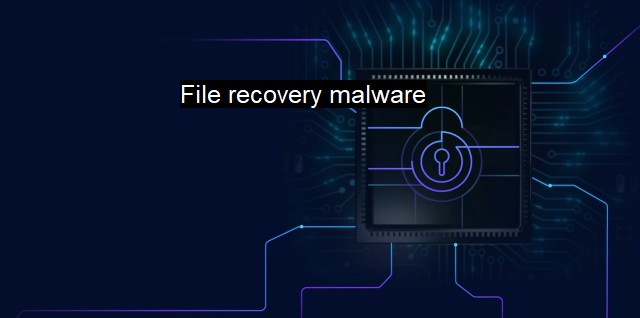What is File recovery malware?
Uncovering the Threat of File Recovery Malware: Characteristics, Effects, and Detection Strategies
File recovery malware is a type of malicious software, or malware, that presents itself as a beneficial utility for retrieving lost or accidentally deleted data. It taps into a computer user's anxiety regarding data loss, encouraging them to download, install, and run the malicious file recovery application under the impression that they will retrieve their lost data. The term "file recovery malware" falls under the broader category of scareware, a type of malicious application programmed to mislead users into believing their system is compromised, leading them to download potentially harmful software.As with most malicious software, the main objective of file recovery malware is to breach system security ciphers, break the integrity of software, and disrupt the overall performance of infected systems. what sets apart file recovery malware from others, is its deceptive functionality. While some malware outright harms or steals user data, file recovery malware initially presents its fraudulent version of a solution to a problem that is non-existent, and in the process, creates actual problems.
One typical way file recovery malware operates is by scanning the infected system and then reporting numerous non-existent problems related to data corruption or loss. It then prompts the user to buy a premium version of the application to fix these alleged issues. In some cases, file recovery malware causes actual problems and then offers its solution, further tricking the user. it could hide files and folders and then claim they were deleted or corrupted.
Cybersecurity plays a crucial role in detecting and removing such malware. Antivirus software applications are indispensable tools in this context, as they use signature-based detection to identify known malware, heuristic analysis for detecting previously unknown malware or modifications of known malware, and sandboxing to isolate potential malware from the system until its behaviour can be assessed. In severe cases, sometimes re-installing the system software becomes a necessary step taken by cybersecurity professionals to completely exclude the risk of leftover malicious portions of file recovery malware.
User training and awareness can be highly effective in combating file recovery malware. Users should be educated not to download software from untrusted sources or click on suspicious links. Users should keep their systems and antivirus software updated, as recent updates often include patches counteracting the latest threats. They should be aware of common malicious tactics, like pop-up windows claiming their computer is in danger.
There are various countermeasures and strategies that can be employed to prevent file recovery malware attacks. Backing up data regularly and keeping an updated backup separate from the network can help recover lost data without having to rely on untrustworthy file recovery tools. Regularly updating and patching operating systems and applications can remove software vulnerabilities that malware can exploit.
File recovery malware is a deceitful type of malware that manipulates users by falsely claiming to recover lost data, and in the process, it exploits the users' system vulnerabilities and security toe-holes. Cybersecurity measures of antivirus applications, accurate user training, a regular backup, and sensible security practices are the best defence against file recovery malware. We must keep in mind that in the cybersecurity field, prevention and proactive strategies are usually much more impactful than attempting to recover from a cyber breach.

File recovery malware FAQs
What is file recovery malware?
File recovery malware is a type of malware that pretends to be a data recovery tool but actually infects your system and encrypts your files. The attackers then demand a ransom to decrypt the files.How does file recovery malware infect my system?
File recovery malware can infect your system through various means, such as phishing emails or malicious software downloads. Once it infects your system, it starts encrypting your files and demands a ransom to restore them.Can antivirus software detect and remove file recovery malware?
Most antivirus software is equipped to detect and remove file recovery malware. However, some strains may be more sophisticated and can evade detection by traditional antivirus software. It is always best to keep your antivirus software up to date and run regular scans to stay protected.What can I do to protect myself from file recovery malware attacks?
To protect yourself from file recovery malware, you should always be cautious of suspicious emails or software downloads. Make sure to keep your antivirus software up to date and regularly run scans on your system. It is also wise to regularly backup your important files to an external source, so you can restore them in case of a ransomware attack.| | A | | | B | | | C | | | D | | | E | | | F | | | G | | | H | | | I | | | J | | | K | | | L | | | M | |
| | N | | | O | | | P | | | Q | | | R | | | S | | | T | | | U | | | V | | | W | | | X | | | Y | | | Z | |
| | 1 | | | 2 | | | 3 | | | 4 | | | 7 | | | 8 | | |||||||